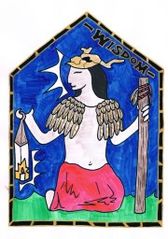Wisdom
The Path of Wisdom
There are many Citizens of the Empire who believe themselves, by nature, to be filled with the Virtue and it comes easily to them, yet the truth is – like all the Virtues – Wisdom is a journey and must ever be striven for. Only the fool believes their journey is complete. Wisdom in the Empire takes many forms and what might benefit you in the Wintermark could as easily be your ruin in Varushka. Wisdom’s natural enemies are folly and complacency who steal the wit and desire for understanding and enlightenment. There is also dispute amongst the Wise as to the extent that knowledge should be shared with the unready lest it imperil them.
Guidance on the Path
Through study of the Paragons and Exemplars, the priests of The Way have gleaned insight into the heart of the Virtue and how best to pursue it. There are collections of parables, tales, sayings and teachings that distill this for Imperial Citizens to learn from. The following are a handful of teachings and sayings deemed to be essential to understanding the Path:
- The Virtuous apply what they have learned; wisdom knows all knowledge is incomplete.
- Let every word you speak carry meaning; do not use forty when four will do.
- Wisdom is not always knowing the answer; wisdom is finding the right question.
- Test what you learn; only fools accept hearsay as truth.
- Despise folly and chastise the fool that spreads it.
Paragons and Exemplars
There are almost no Paragons and Exemplars of Wisdom recognised in their lifetimes. The majority tend to be revealed after their time when the questions they posed have been understood, and their insights and judgements have proven sound. Recognised Paragons of Wisdom include:
- Zoria, a Paragon whose legends date back to when the Ushka were a young people. So legend has it, Zoria was a Sorceress possessed of great insight and knowledge who lived in the depths of the Great Wilds and learned the names of all the creatures of the wild; bird and beast, fish and fowl. Using their names, Zoria could command them and they served her. One day, in return for a kindness done to her by a hunter lost in the Great Wilds, she commanded beasts to serve the hunter by carrying burdens, providing wool, food and companionship. The hunter went on to be the first farmer and their tribe prospered.
- Isenbrad of the Steinr is also known as a Paragon of Wisdom. A smith known for good judgement and counsel, Isenbrad quested with Godric against a terrible troll kingdom. Upon the loss of their weapons, Isenbrad turned his legendary skills to shaping weapons of ice and carved the secrets of his art upon the walls of the cave using runes.
- Atun of the Highborn, one of the famed Twin Navigators, who - along with Atuman, Exemplar of Ambition - steered the ships that bore the Highborn through unknown waters to their new homeland, as part of their exodus from their doomed home. After the landing, Atun followed a vision of her own and sailed away to an unknown destination. She left behind some students who honoured her memory and ultimately became the Scions of Atun and devoted their lives to spiritual matters, including unlocking the mysteries of liao.
Recognised Exemplars of Wisdom include:
- Kala
- Avigliana di Arvos of the League.
Symbols, icons and trappings
The Path of Wisdom has many symbols across the Empire. Before the formation of the Synod, animal sigils were popular, in recognition of Zoria’s mastery of animals. However, the Synod has since discouraged this as The Way exalts the human spirit and beasts are lesser (though the practice exists still in parts of Varushka). As a consequence, more widely accepted symbols are scales as used by Kala to weigh and measure the world, and a lantern as used by Isenbrad to illuminate the cave in which he carved his secrets in runic form.
Many Priests and Pilgrims of the Path of Wisdom often carry sources of light, or the means to provide such. Many also carry the means to record such knowledge and wisdom that they encounter.
